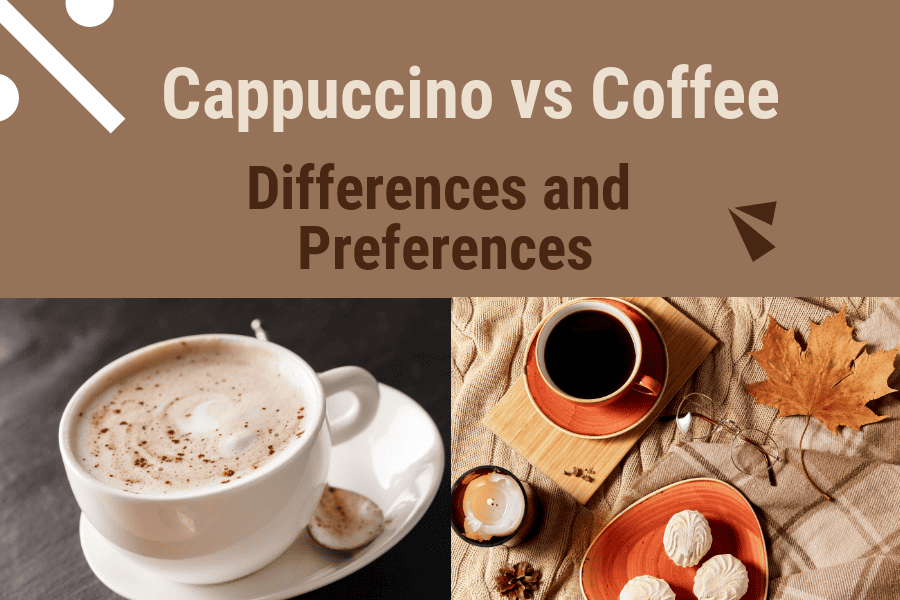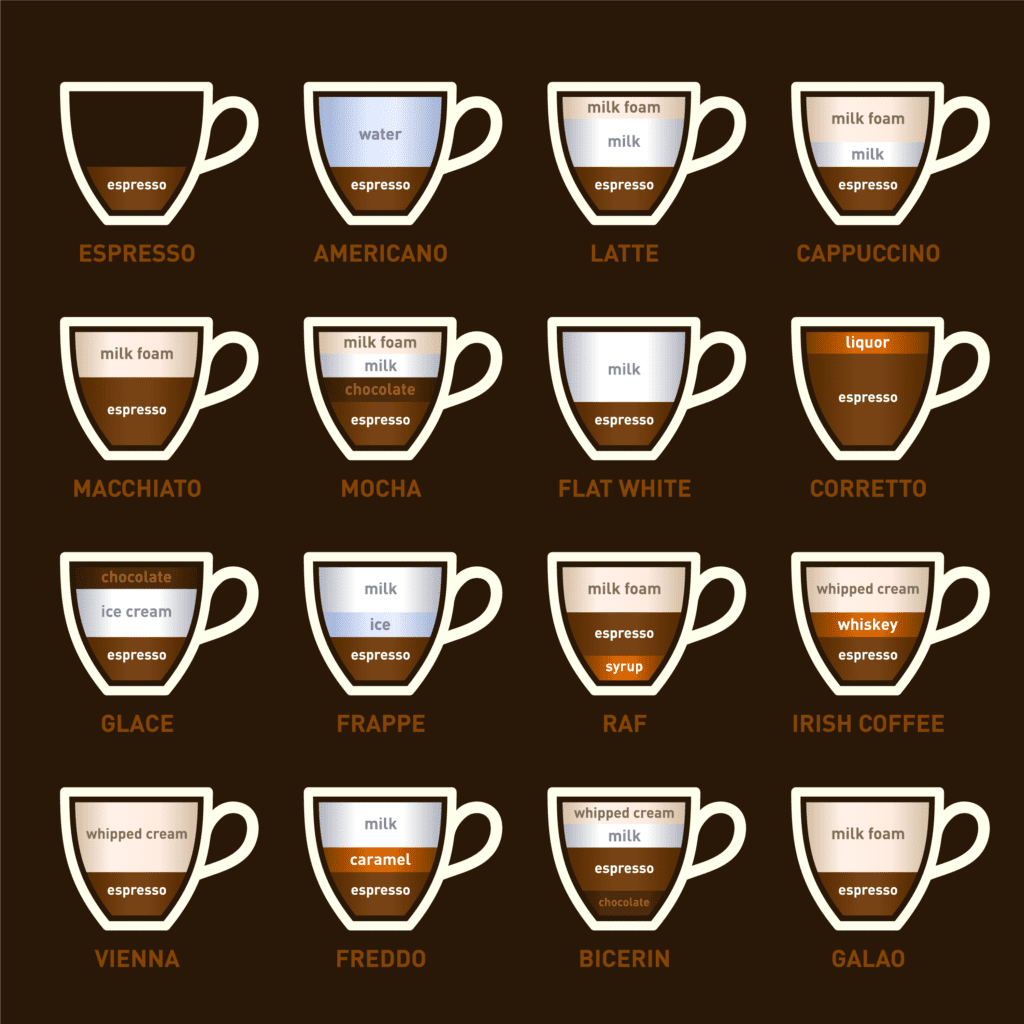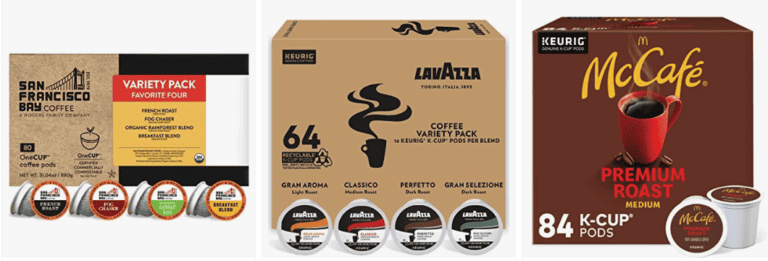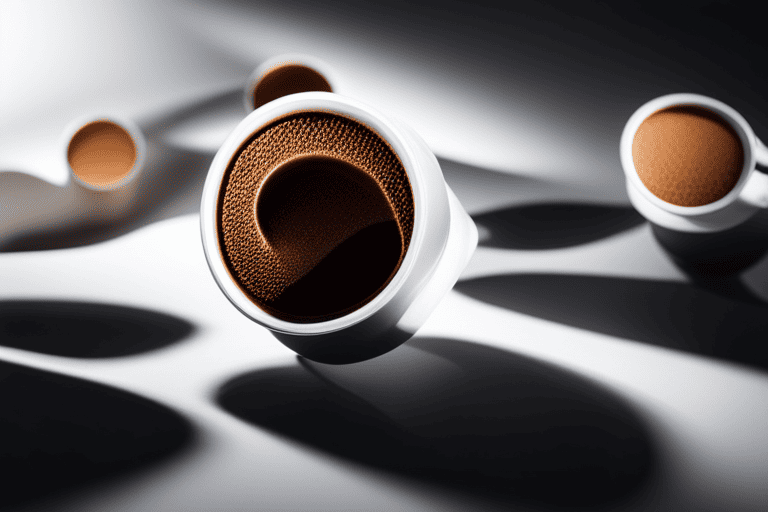Cappuccino vs Coffee: Exploring Key Differences and Preferences

When it comes to enjoying a delicious and satisfying cup of coffee, most of us are familiar with the fundamental choice between a classic coffee and a cappuccino. These two caffeinated beverages have their own unique characteristics, and understanding the differences between them can help us make a more informed decision on which to choose depending on our preferences.
A cappuccino is an Italian frothed milk and coffee drink made using an espresso machine. In its traditional form, a cappuccino consists of 25 milliliters of espresso coffee and 100 milliliters of steam-foamed milk, with some variations calling for equal parts espresso, steamed milk, and microfoam (MasterClass). On the other hand, coffee is a brewed beverage made by combining hot water with ground beans, resulting in a less-milky and more straightforward coffee experience.
Among the key differences between a cappuccino and coffee are the milk content and preparation methods. A cappuccino features a higher foam content and is typically served in a cup, whereas coffee is served in a variety of ways and does not involve frothing or foaming the milk (Your Dream Coffee). As we explore this topic further, we will delve into other essential contrasts between these two beloved beverages, such as flavor, strength, and cost.
Cappuccino vs. Coffee: Basics and Differences
In this section, we will discuss the basics and differences between cappuccino and coffee, covering their types and variants, as well as the ingredients and ratios used in each.
Coffee Types and Variants
Coffee comes in various types and forms, each with its unique preparation methods and flavor profiles. Some of the most popular coffee variants include:
- Espresso: A concentrated form of coffee made by forcing hot water through finely ground coffee beans.
- Latte: A coffee drink made with espresso and steamed milk, typically consisting of one-third espresso and two-thirds milk.
- Americano: A blend of espresso and hot water, which results in a taste resembling drip coffee.
- Macchiato: An espresso with a small amount of foamed milk on top, perfect for those who want a stronger coffee flavor.
- Black Coffee: Coffee served without milk or any additives, such as drip coffee, French press, or percolator.
- Iced Coffee: Brewed coffee served over ice, which can either be black or mixed with milk and sweeteners.
- Instant Coffee: A powdered form of coffee that dissolves in hot water, ideal for those who need a quick caffeine fix.
- Aeropress: A newer coffee-making method that uses air pressure to extract coffee, resulting in a smooth and flavorful brew.
- Flat White: Similar to a latte but with more microfoam and a stronger espresso flavor.
Ingredients and Ratios
The main difference between cappuccino and coffee lies in the milk content and the ratios of each ingredient used. Let’s explore these differences:
| Coffee Variant | Ingredients | Ratio |
|---|---|---|
| Cappuccino | Espresso, Steamed milk, Microfoam | Equal parts espresso, steamed milk, and microfoam |
| Espresso | Coffee grounds, Hot water | 1:1 to 1:2 coffee to water |
| Latte | Espresso, Steamed milk | 1:2 to 1:3 espresso to milk |
| Americano | Espresso, Hot water | 1:1 to 1:3 espresso to water |
| Macchiato | Espresso, Foamed milk | 1:1 espresso to milk |
| Black Coffee | Coffee grounds, Hot water | 1:15 to 1:18 coffee to water |
| Iced Coffee | Coffee grounds, Cold water or ice | 1:15 to 1:18 coffee to water/ice |

As seen in the table above, cappuccino is unique in its equal parts ratio of espresso, steamed milk, and microfoam. This composition gives it a distinct taste and texture when compared to other coffee variants, which generally have different ingredient proportions.
Beverages Preparation and Techniques
Brewing Methods
In coffee preparation, the brewing method plays a crucial role in the final taste and texture of the drink. The main difference between coffee and cappuccino lies in the use of water and milk. Coffee is made with roasted coffee beans and hot water, while cappuccino is made with espresso, steamed milk, and frothed milk. A brewed coffee can be prepared in various ways, like using a drip coffee maker, a French press, or a pour-over method.
Milk Steaming and Foaming
For cappuccino, the perfect balance between steamed milk and foamed milk is essential to achieve the desired texture and taste. In this process, steamed milk is combined with espresso and topped with a layer of frothy milk, creating a creamy beverage with a rich coffee flavor. As a barista, mastering the art of milk steaming and foaming is vital, as it helps create the frothy texture that distinguishes cappuccino from brewed coffee. This skill enables cafes to offer their customers a delicious and authentic cappuccino experience.
Coffee Grinding and Roasting
Both coffee and cappuccino begin their journey with coffee beans. The magic starts with the selection and roasting of quality beans, as the roasting process brings out the flavors and aroma of the beans. Once the beans are roasted, they need to be ground to the proper consistency. For brewed coffee, a slightly coarse grind is used, while for espresso, a finer grind is preferred.
The choice of grinder is essential for achieving the perfect grind size. A burr grinder is recommended for consistent results. The grinding process provides the baristas with the coffee grounds needed to prepare both cappuccinos and brewed coffee, allowing them to craft an assortment of beverages in their cafes.
Taste, Flavor, and Aroma
When it comes to cappuccino and coffee, the taste, flavor, and aroma can vary significantly depending on various factors. In this section, we will explore these differences and how they relate to caffeine content, coffee strength and bitterness, as well as the effects of milk and sweeteners.
Comparing Caffeine Content
Although one might assume that cappuccinos are stronger than coffee due to the presence of espresso, this is not always the case. A double-shot cappuccino typically has 180 mg of caffeine, while an average cup of coffee contains about 150 mg of caffeine (source). Nevertheless, the caffeine content can vary depending on the type of coffee bean, the roast level, and preparation method.
Coffee Strength and Bitterness
As for the strength and bitterness, coffee generally has a stronger taste compared to cappuccinos since it is brewed with water and does not include any milk (source). The roast level of the coffee beans can also impact the flavor and aroma, with dark roasts typically producing a stronger, more bitter taste, while light roasts generate a milder flavor and lighter aroma.
Milk and Sweeteners Effects
The addition of milk in a cappuccino creates a smoother, creamier texture and can soften the overall flavor, whereas coffee has a more robust taste. Steamed milk in a cappuccino can also change the aroma, resulting in a mellower scent compared to coffee (source). Utilizing sweeteners or flavorings in cappuccinos and coffee can drastically change the taste, often masking the bitterness of coffee and enhancing the flavors in a cappuccino. However, it is crucial to experiment with different sweeteners and flavorings to find the optimal balance for your personal preference.
Calories and Nutrition
When comparing cappuccino and coffee, it’s essential to consider the nutritional differences between the two beverages. Factors such as calories, milk types, sugar, and syrup can impact their overall effect on our health.
Milk Types and Alternatives
Traditional cappuccinos contain steamed milk and milk foam, contributing to the calorie count. A classic cappuccino has around 110 calories and 6 grams of fat. However, a 16 oz Starbucks cappuccino has 140 calories. In contrast, a regular cup of coffee has virtually no calories. The type of milk used can also affect the nutrition and calorie content of the drink:
- Whole milk: higher in calories and fat
- Low-fat milk: can reduce the calorie count and fat content of a cappuccino
- Non-dairy alternatives: options like almond, soy, or oat milk can vary in terms of calories and nutrition, but are generally lower in calories and fat than whole milk
Sugar and Syrups
Adding extra sugar, syrup, or cocoa powder to cappuccino can quickly increase the number of calories in the drink. Additionally, flavored syrups such as vanilla, hazelnut, and caramel can boost the drink’s sweetness and calorie content. It’s important to note that decaf versions of coffee and cappuccino can have similar calorie counts, as the calorie difference primarily comes from the added milk and sweeteners.
When watching our calorie intake or opting for a healthier choice, we can consider using sugar substitutes or sugar-free syrups. Alternatively, enjoying our coffee black, without any milk or additives, can keep the calorie count minimal.
Customization and Personal Preference
When it comes to choosing between cappuccino and coffee, personal preference plays a large role in determining the perfect beverage for each individual. There are numerous ways to customize these drinks, allowing for a wide range of preferences to be satisfied. In this section, we’ll explore the various options available at coffee shops and discuss how you can create your perfect cup at home, as well as popular additions that can enhance the taste and consistency of your drink.
Coffee Shop Options
At most coffee shops, you’ll be presented with a wide array of options when it comes to cappuccinos and regular coffee. In addition to selecting between a dark roast, medium roast, or even a refreshing cold brew, you have the freedom to customize your drink with different milk types, flavors, and toppings. Some popular options for cappuccinos include milk foam, cocoa powder, and cinnamon, while coffee drinkers may enjoy a double shot for an extra kick of caffeine. Seasonal offerings, such as ráfagas and chillers, also provide exciting variations to your usual drink order.
Creating Your Perfect Cup
Creating your perfect cup of coffee or cappuccino at home allows you to further tailor the taste and consistency to your personal preference. It’s essential to start by selecting the right beans and roast for your desired flavor profile. From there, you can experiment with different brewing methods, such as pour-over, drip, or espresso machines, depending on the type of drink you’re crafting.
For cappuccino enthusiasts, mastering the art of steaming milk to create a frothy layer of bubbles is an essential skill. Similarly, for those who prefer regular coffee, adjusting the water-to-coffee ratio can help achieve the desired strength and flavor.
Popular Additions
Beyond the basic elements of cappuccinos and coffee, there are a handful of popular additions that can elevate your drink to new heights. For instance:
- Milk alternatives like almond or soy milk can cater to dietary restrictions or preferences.
- Adding syrups and flavored creamers provide a burst of flavor to complement the natural taste of the coffee.
- Experimenting with spices, such as cardamom or nutmeg, can offer a warm and unique addition to your drink.
- For those who enjoy a cold beverage, a simple serving of ice transforms your coffee or cappuccino into a refreshing treat.
Ultimately, the type of coffee or cappuccino you prefer comes down to your personal tastes and preferences. Whether it’s a strong, dark roast or a frothy cappuccino sprinkled with cocoa powder, experimenting with different options and ingredients can help you find your perfect creation.





